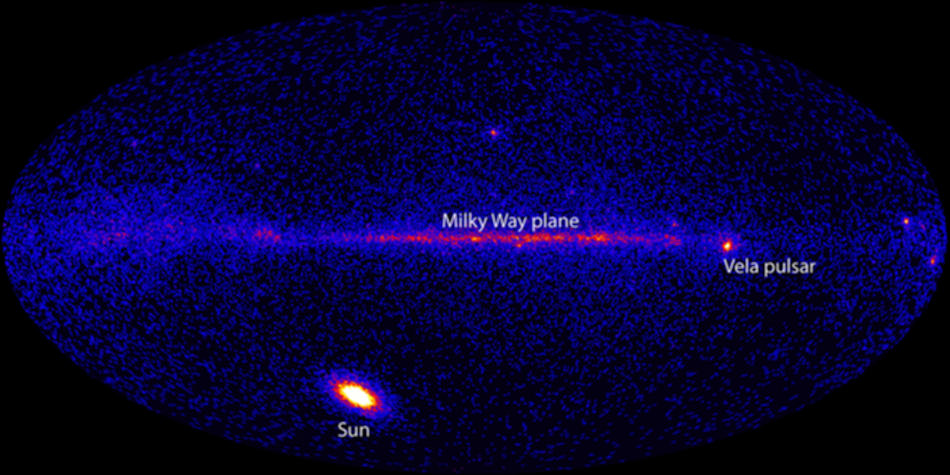
 Credit: NASA/DOE/Fermi LAT Collaboration
Credit: NASA/DOE/Fermi LAT Collaboration
The Gamma-Ray Sun
The Sun goes through 11-year alternating cycles of quiescence and activity, driven by changes in the solar magnetic field. In its active period the Sun produces large numbers of sunspots, along with solar flares. Solar flares are giant eruptions of mass and radiation which bombard the inner solar system. Since March 2006, when the Sun reached the minimum of its activity cycle, the frequency and intensity of solar flares has been increasing. Solar flares produce enormous amounts of energy: a large flare can release enough energy to power the entire United States for 100,000 years. The first solar flare ever observed was also the largest ever observed. This flare was seen by a solar astronomer named Richard Carrington and by Richard Hodgson at 11:18 AM Thursday, September 1, 1859. This flare produced enormously bright aurorae, and did significant damage to the world's telegraph system. A similar event today would probably destroy our modern telecommunications system. So it's vital to keep an eye on the Sun's magnetic behavior. Richard Carrington viewed his flare in visible light; but flares also emit much higher energy radiation. The highest energy radiation so far detected from a solar flare was seen by the Large Area Telescope on the Fermi Gamma-Ray Space Telescope on March 7, 2012. This strong flare produced radiation which was about 2 billion times more energetic than visible light. Fortunately the total amount of energy which reached earth from the March 7 flare was much less than in the Carrington flare, so little damage was done. The image above shows the LAT all-sky image from March 7, showing that, on this day, the Sun was the brightest gamma-ray object in the Universe.
Published: June 25, 2012
<
HEA Dictionary ● Archive
● Search HEAPOW
● Other Languages
● HEAPOW on Facebook
● Download all Images
● Education ● HEAD
>

Each week the HEASARC
brings you new, exciting and beautiful images from X-ray and Gamma ray
astronomy. Check back each week and be sure to check out the HEAPOW archive!
Page Author: Dr. Michael F. Corcoran
Last modified Tuesday, 27-Feb-2024 10:08:22 EST


